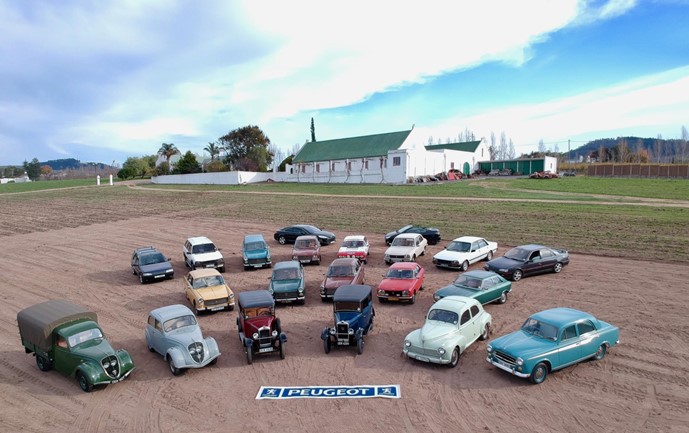A brief history of Peugeot
When it comes to automobile brands, Peugeot is amongst the oldest and began its foray on the African continent very soon after it was created. The Peugeot lion, symbolising the qualities of the saw blades produces by Peugeot Frères, was registered in 1858. It began to roar in Africa at the end of the 19th century, making it one of the oldest automobile brands on the continent.
The legendary French company was founded in 1810 with a steel foundry that quickly began making saws and other tools, before moving on to coffee and pepper grinders – the ones you will still find on your table today – before bicycles and, finally, the first automobiles, the first of which was a steam tricycle exhibited in 1889.
The pioneer years
Even if the Bey of Tunis drove a Type 4 in 1892 during his trips to Paris, he did not bring it back to Africa for lack of a suitable road. Africa had really got into Peugeot history on the ground floor. The hand-built car was constructed with assistance from some members of the Peugeot family and the French lion got its first tracks in Africa.
The South African connection didn’t happen until four years later – and it didn’t happen in South Africa. A Johannesburg resident, Albert Atkey, participated in the famous “Emancipation Run” of 1896 from London to Brighton as a passenger in the Peugeot of his friend, Charles Stewart Rolls. Yes, the Rolls of Rolls Royce!
But it wasn’t until 1902 that Benjamin and Lawton of Cape Town imported the first Peugeot into South Africa. It promptly competed in the first motor sports even in the country, a speedy trial on the Groote Schuur Estate in Cape Town the following year.
Also in 1902, a Mr. “Yankee” Jenkins began importing Peugeot delivery vans in South Africa.
In 1903, William Atkinson founded the Atkinson Group that many years later hand the franchise for import Peugeots, while a Peugeot was also the first vehicle in Natal.
The Peugeot lion – initially depicted walking on an arrow – was gaining traction at the southern tip of Africa and, in 1906, one Natal Peugeot owner and 27 other cars owners of Durban, formed the very first club called the Natal Automobile Club in 1906.
By the 1920s, Peugeot cars were still steadily imported into South Africa exclusively through H. Jasper Smith, including the Quadrilette. In the late twenties the 2.0-litre Type 183 was the most prominent imported PEUGEOT and the trend continued in the 1930s with 201s and after World War II with 202s and a few 402s. The 202 could be found in many towns nationwide, including a 1947 ex-war stock 202 pickup that is still rolling in Hermanus.
The dawn of a new era with the 203
Peugeot really started making its name from 1948 onwards with an almost indestructible car, the 203. Notwithstanding its small engine of 1,290 cc, it was every match for any big American car and the 203 built a reputation for Peugeot as one of the toughest cars on the road. This was confirmed in 1951 when it conquered 950km daily for 17 days from Cape Town to Paris via Algiers, a feat successfully repeated 50 years later with two 50-year-old 203 station wagons.
In 1950, National Motor Assemblies (or Assemblers), part of the Stanley Motors Group, started manufacturing 203 cars at Natalspruit industrial site in Alberton, near Germiston, south of Johannesburg. In that year 112 cars were sold. The 403 followed in 1956 and some of them were assembled at the Chrysler factory in Elsiesrivier between Bellville and Cape Town.
Comfort, economy, and durability coupled with superb road holding, precise steering and excellent brakes were the hallmarks of these cars and they built up a tremendous reputation in South Africa, especially in the country districts.
During the 1950s, many enthusiasts also participated in saloon car racing with their modified 203s and 403s. One such 203, belonging to Philip Wagner of Nature’s Valley in the Tsitsikamma, is still on the road today and ready for 0 – 100 km/h in 10 seconds and a top speed of nearly 180 km/h.
The golden years
Then came the 404, which was sold from 1960 until 1978, three years longer than in Europe because of the high demand for this invincible car.
The 404 also rose in popularity thanks to its successfully rally career – especially in the East African Safari Rally in the mid-1960s – and in Cape Town, where Clarence Taylor was a familiar sight on the Killarney race track in his 404 sponsored by Atkinson’s Motors.
During the 1960s, a locally developed 404 GT (also known as the 404 Sport) was built with an improved 1,618 cc engine done by the biggest PEUGEOT dealer at that time, Stanley Motors. With the help of an engineering group called Super performance and under PEUGEOT observation, improved engine breathing gave more power and torque with a slightly higher top speed, while retaining a full and official PEUGEOT guarantee. It was mainly sold in the Johannesburg area but some other dealers in the country also received a few.
The creation of Peugeot Automobile Africa (PAA) in 1969 was followed by the takeover of the Natalspruit production and began Peugeot’s most successful years in the country. During the 1970s another unique South African 404, the GL, was built. It had a 1,8-litre motor with sport seats, central console, and floor gearshift and during this time, Hillman owners could choose between a 404 or a 504 engine to power their car.
1972 was an important date with more than 10,000 Peugeots registered for the first time. 1973 was the brand’s best year ever, with almost 17,000 registrations and the 404 became the 4th most popular car in South Africa.
In 1974, both 404 and 504 (sedan, estate, Super 7 and bakkie) were built at Natalspruit and 504 carried on the previous success of 404 on the African tracks and gravel roads.
Twilight times
At the end of 1978, Peugeot Automobile Africa was taken over by the Sigma Motor Corporation for R30 million. The Natalspruit factory was sold and closed and the manufacture of Peugeots 504s, 305s and 505s was transferred to Silverton in Pretoria next to Mazdas. Local production of Citroën ceased altogether.
In 1985 Sigma Motor Corporation merged with Ford and became Samcor. The new management decided to give up with Peugeot: 931 cars were produced in 1985 out of an overall 186,974 locally built units since 1970 in stark contrast to the 1,000 units per month and 5,5% market share enjoyed under French management.
The last models built in South Africa were the 504 and 505 along with small successes from the 305. The most luxurious and fastest Peugeot built in South Africa was the 2,2-litre 505 GTI, with approximately 350 built and a number remaining as collector’s items.
The Lion is back
No PEUGEOT cars were imported between 1986 and 1994 before McCarthy Motor Holdings took the bold step to introduce the 206. In six years, 5,000 Peugeots hit South African roads and in 2002, Peugeot Motors South Africa (PMSA) officially became a new Peugeot subsidiary in charge of the Southern Africa Customs Union (South Africa, Namibia, Botswana, Lesotho, and Swaziland).
A year later, a new national training centre was opened by Christian Peugeot, fifth-generation member of the founder family and then-Director of Quality of Marketing worldwide. With it came the striking “Blue Box” dealerships and Peugeot registered 5,000 units that year.
The French lion has its latest chapter under the Stellantis banner following the successful merger of Peugeot S.A and Fiat Chrysler Automobiles N.V and the establishment of Stellantis South Africa in 2021. The historic merger of equals created one of the largest automobile companies in the world and a firm foundation for Peugeot to continue growing. Fitting that the Peugeot 2008 was named South African Car of the Year that same year.
With one of the freshest and most innovative model ranges on the African market, there’s a Peugeot for every application available today. The Peugeot 208 offers stylish hatchback motoring. The 2008, 3008, and 5008 SUVs offer versatility with flair, while Landtrek returns Peugeot to the pick-up market in Africa. For business, the partner and boxer tick all the commercial boxes. Peugeot really does provide a mobility solution par excellence across the board, so go test drive one today and experience the roar of the French lion in Africa.










